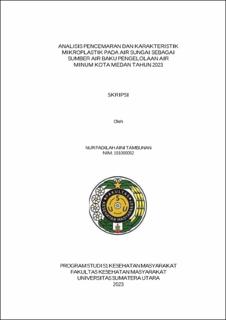Analisis Pencemaran dan Karakteristik Mikroplastik pada Air Sungai sebagai Sumber Air Baku Pengelolaan Air Minum Kota Medan Tahun 2023

Date
2023Author
Tambunan, Nur Fadilah Aini
Advisor(s)
Santi, Devi Nuraini
Metadata
Show full item recordAbstract
Waste has been one of the biggest ongoing issues faced in Indonesia and is
increasing along with the population growth and activities. Microplastics is the
smallest part of plastics with the size of less than 5 mm. This study was done to
understand the physical quality, amount, and characteristics of the microplastics
found in the rivers which are used as raw water source in the management of
drinking water in Medan 2023. This was a qualitative study with descriptive
approach. The river water used in this study came from Sunggal, Belumai, and
Denai River in Medan. Sunggal River had a turbidity of 8.64 NTU, colour of 11.7
TCU with no odour at 29°C. Belumai River had a turbidity of 7.29 NTU, colour of
5.8 TCU with no odour at 30°C. At the same temperature, Denai River showed a
parameter of 8.9 NTU and 12.3 TCU for turbidity and colour, with no odour. The
physical parameters of these rivers meet the standards and regulations of Ministry
of Health of Indonesia No. 2, 2023 for use as raw water source. The amount of
microplastics particles in Sunggal, Belumai, and Denai River were 22, 19, and 25
particles/liter, respectively. The characteristics of microplastics based on shape
were fibres, fragments, films, and pellets. Meanwhile, the size was categorized as
1-2 mm, 0.5-1 mm, 0.1-0.5 mm and <0.1 mm. Most of the microplastics were black
in colour. In addition to microscopy assessment, it is recommended to use Fourier-
Transform Infrared Spectroscopy for future studies to understand the chemical
bonds from the microplastics samples to be able to determine the types.
Collections
- Undergraduate Theses [3186]
